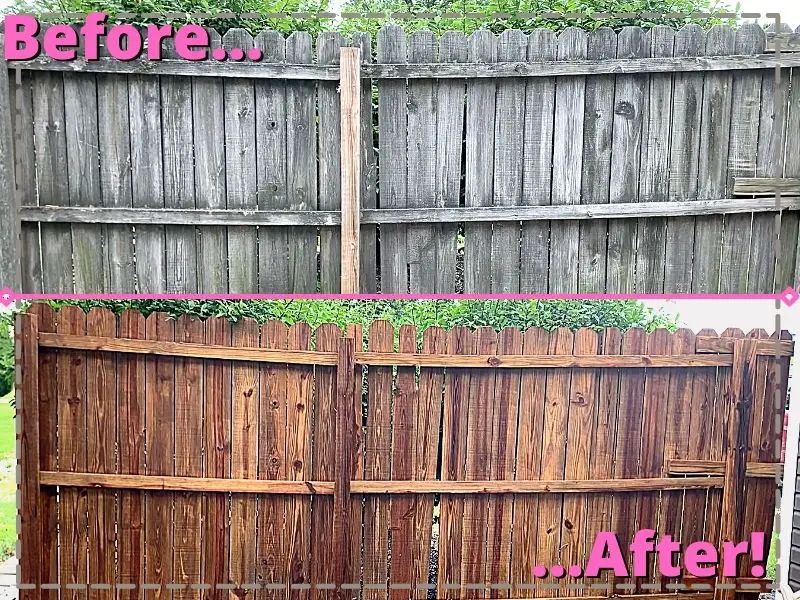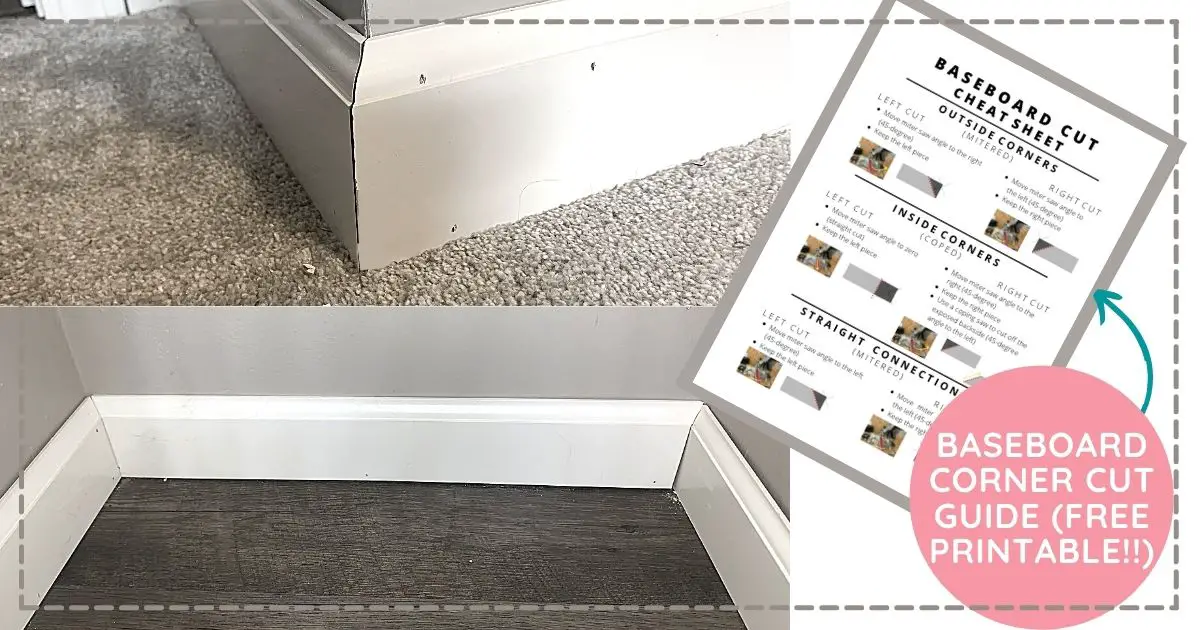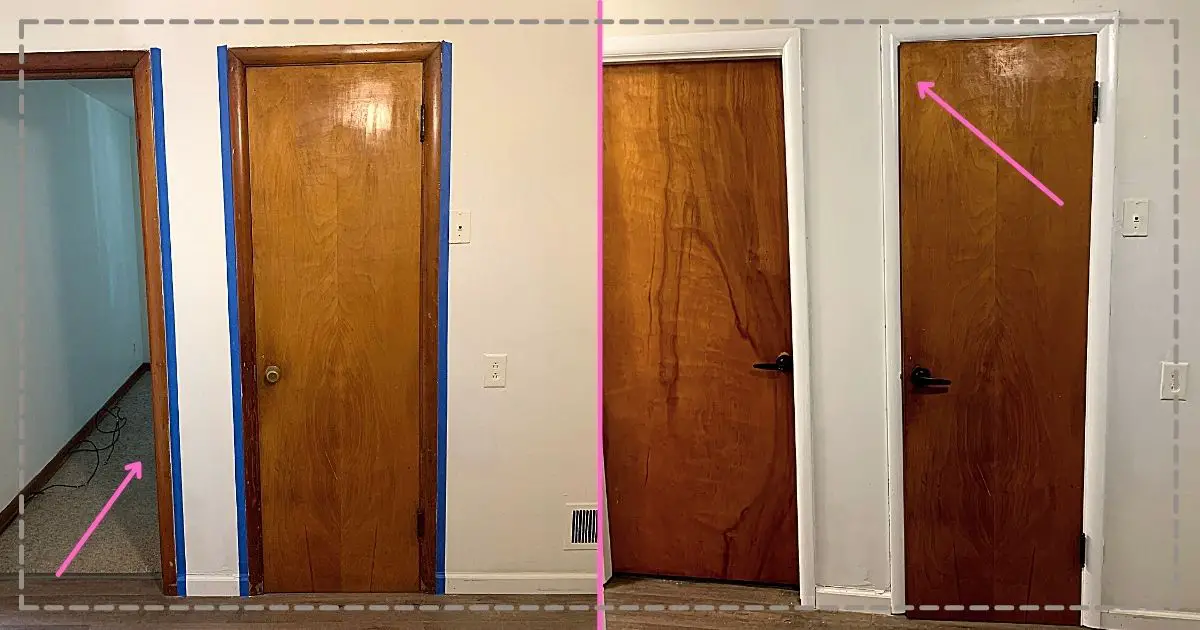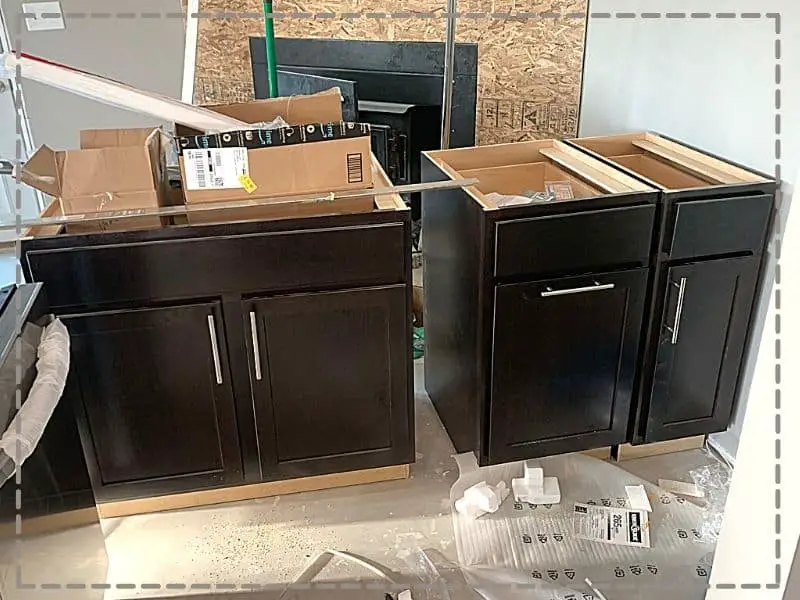*My posts may contain affiliate links, which means I may receive a small commission, at no cost to you, if you make a purchase through a link! Thank you for supporting my website!*
Last updated on February 29th, 2024 at 05:06 pm
Are you starting to update the exterior of your home and wondering how to clean a wood fence before staining it? Well, look no further because I’ve got your answer!
Wood fences can be cleaned with a pressure washer or by hand before staining. Use a pressure washer at 1500-2000 psi with a 25-40 degree angle spray. Alternatively, use a 1 part bleach: 2 parts water mixture and a scrub brush to hand scrub the fence clean. All algae and dirt must be removed before staining.
Yes, it’s that simple! However, I must say it’s MUCH faster (and easier) to use a pressure washer than it is to hand scrub.
So if it’s possible, I would look into borrowing, renting, or purchasing one to complete your wood fence staining project.
But for those that don’t have that option, hand scrubbing will get the job done as well. I’ve covered both ways to better help you on your journey below.
Let’s dive in!
Quick Navigation: How To Clean A Wood Fence Before Staining
- How To Clean A Wood Fence Before Staining With A Pressure Washer
- How To Clean A Wood Fence Before Staining Without A Pressure Washer
- Other FAQs About Cleaning A Wood Fence Before Staining
- Final Thoughts
| Level Of Difficulty | Time To Complete |
|---|---|
| Easy | 2-3 Hours |
| Material List | Tool List |
|---|---|
| Bleach | Pressure Washer |
| 5-Gallon Bucket | Hose |
| Empty Spray Bottle | Soft-Bristled Scrub Brush |
| Old Putty Knife |
How To Clean A Wood Fence Before Staining WITH A Pressure Washer
By far, the best, easiest, and fastest way to clean a wood fence before staining is to use a pressure washer.
Pressure washers not only will easily remove green algae, dirt, and debris, but they also can blast off old paint and any irregularities within the wood.
The only disadvantage to using a pressure washer to clean your fence is if you use too high of pressure on the wood. That can lead to chunks of wood being ripped out.
Don’t worry about that small problem though, I’ll help you easily avoid that in the steps below!
Step One: Hook Up the Water Supply
The first step to cleaning a wood fence before staining with a pressure washer is to hook up the water supply to the pressure washer.
Take your hose and screw it into the water input nozzle on your pressure washer.
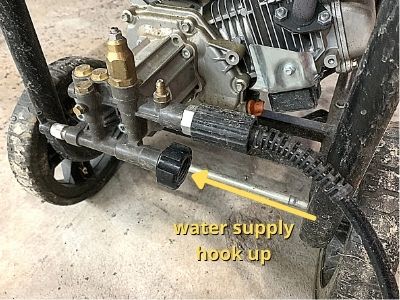
After the hose is screwed on tightly, turn on the water supply, and let the water flow through the hose and into the pressure washer.
Warning: Never turn on a pressure washer without the water supply turned on. Without water, the pressure washer and hose can become damaged.
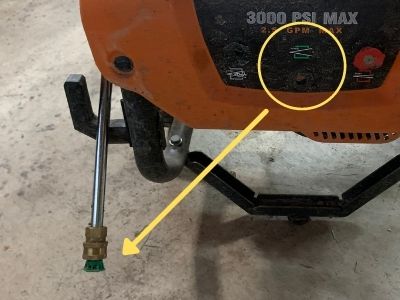
Also, switch out the spray tip to a 25-degree spray tip before turning the pressure washer on. (A 15-degree or 40-degree spray tip works also. Just remember, the smaller the spray degree, the tighter and harder the stream of water that will come out.)
Once the water’s on, let’s move on to the next step.
Step Two: Start The Pressure Washer & Set The Pressure
The next step to cleaning a wood fence before staining with a pressure washer is to start up the washer and select the correct pressure.
For a gas-powered pressure washer, pull the choke out, put your foot on the leg of the machine to hold it in place, and quickly pull the cord until the engine starts. (This might take several pulls if the engine is cold.)
After the engine is running, push the choke back in and wait a couple of minutes for the pressure to build.
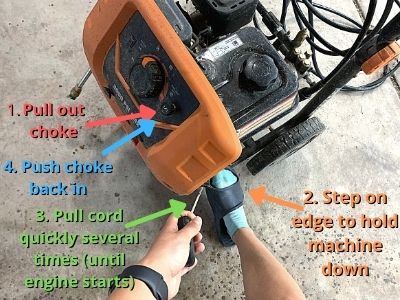
For an electric-powered pressure washer, press and hold the start button. Once the engine is running, wait a couple of minutes for the pressure to build before spraying.
While the pressure is building, set the pressure gauge to medium-high (1500-2000 psi).
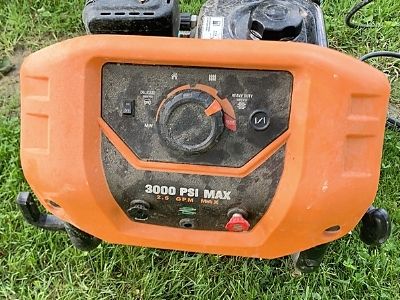
To test the pressure, point the nozzle away from anything/anyone and pull the trigger.
Once the spray is consistent, then you can move onto the next step.
Step Three: Spray The Fence With The Pressure Washer
The last step to cleaning a wood fence before staining with a pressure washer is to spray the fence.
While holding the end of the wand 18 inches away from the wood fence, pull the trigger and continuously sweep the spray back and forth across the wood.
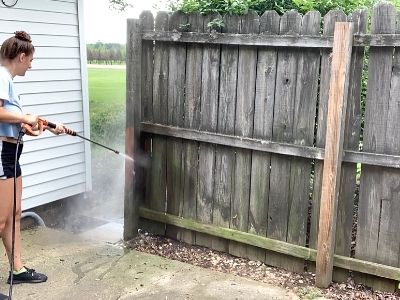
Avoid holding the spray in one spot for too long. Otherwise, you can damage the wood fence.
If it takes more than 1-2 passes across the wood, then slowly move the nozzle a few inches closer to the wood. Continue to move closer until you can easily remove algae and dirt with 1-2 passes of the spray.
Be careful not to move too close because this can damage the wood fence.

We are looking for the color of the wood to change to a natural color, and once the color stays consistent after a couple of passes, your spray is close enough to the fence to properly clean it.
Continue to spray the fence until all dirt and algae are removed. Once the fence has dried for 24 hours or more, your fence is ready for stain or a sealant!
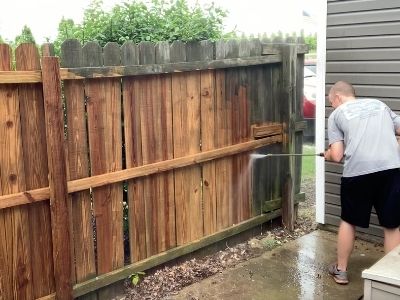
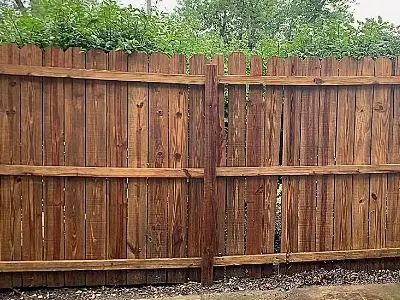
P.S. If you’re not feeling the idea of staining your fence anymore, then you need to check out my article on how to protect your fence for the long term after pressure washing. Staining or painting is not always the requirement, so check it out here to make sure you’re preserving your hard work properly!
How To Clean A Wood Fence Before Staining WITHOUT A Pressure Washer
If you don’t have a pressure washer on hand (and can’t borrow or rent one), then you’ll likely have to put some elbow grease into the fence-cleaning process.
No worries though, this process is relatively cheap to complete and will still successfully prepare your wood fence for stain.
Step One: Spray Bleach Mixture On The Wood Fence
The first step to cleaning a wood fence before staining without a pressure washer is to spray a bleach-water mixture on the fence.
First, in a 5-gallon bucket, mix 1 part bleach: 2 parts water and pour it into an empty spray bottle.
Second, spray the bleach mixture over the stains/algae-covered part of the fence, especially focusing on areas with the heaviest amounts of algae and moss.
Let the mixture soak on the fence for a minute or so. Then you can move on to the next step.
Step Two: Scrub & Rinse Off Bleach Mixture With Water
The last step to cleaning a wood fence before staining without a pressure washer is to scrub and rinse the bleach-water mixture off of the fence.
First, use a soft-bristled scrub brush and work the bristles into the algae and dirt-covered areas.
Second, use your hose and spray off the bleach mixture.
If the algae are still there, then you might have to repeat spraying it with the bleach mixture and scrubbing the dirt and debris off.
If the brush isn’t doing the trick, then you might want to try scraping the thick part of the algae off with a putty knife before continuing to scrub with the bleach mixture.
Repeat this process until all of the algae, moss, and dirt is gone. Then you’re all done, and you’ll have a nice, clean fence that’s ready for stain or a sealant!
Other FAQs About Cleaning A Wood Fence Before Staining
Here are some other frequently asked questions that you might need to help you better clean your wood fence before staining!
Can You Stain A Dirty Fence?
Staining a dirty fence can result in the stain not absorbing into the wood evenly through the layer of dirt and algae. In addition, any topcoat applied can more easily peel off since it cannot adhere properly to the wood itself. It is best to thoroughly clean a fence before staining for long-lasting results.
Can You Pressure Wash Pressure Treated Fences?
Pressure washing treated fences is recommended to help keep the fence clean and protected from insects/algae that can cause long-term damage. To pressure wash a treated fence, use 1500-1800 psi with a 25-40 degree nozzle and continuously sweep the spray over the wood. Avoid spraying too close and damaging the wood.
How Much PSI Do You Need To Pressure Wash A Fence?
The recommended psi to pressure wash a fence is 1500-1800 psi. While pressure washing, use a 25-40 degree nozzle and hold the wand 12-18 inches away from the fence to prevent damage. Use a continuous sweeping motion while spraying to clean the fence from mold, algae, dirt, and mildew.
How Do I Get Green Algae Off My Wood Fence?
To quickly remove green algae from a wood fence, use a pressure washer at 1500-1800 psi. The pressure washer will remove caked-on algae with a few passes of the spray. Spraying a 2 part water: 1 part bleach mixture on the algae and hand scrubbing with a brush will also remove green algae from a wood fence.
How Do You Clean A Wood Fence With Vinegar?
According to Hunker, you can mix 2 gallons of water, 1 cup of white vinegar, and 1/2 cup of liquid dish soap in a bucket to clean a wood fence with vinegar. Spray the vinegar mixture onto the fence and scrub it with a soft-bristled scrub brush until all the algae, mildew, and dirt are gone.
Should You Clean A Fence Before Painting?
Cleaning a fence before painting is vital to the paint adhering to the fence properly. Painting a dirty fence can result in the paint peeling off since dirt and algae can create a layer between the wood and paint. It is best to thoroughly clean a fence before painting for long-lasting results.
Before you paint, you can also repair other parts of your fence to renew it. Family Handyman’s got some good tips for this here.
What Can I Use To Clean My Fence?
To clean a fence, you can use a power washer or a hand scrub and bleach mixture. Pressure washing a fence is faster than hand scrubbing with a bleach mixture, but both methods will clean the fence and prepare it for stain, paint, or sealant.
Final Thoughts On Cleaning A Wood Fence Before Staining
There you have it! Now your fence will look brand new again without needing to replace the entire thing.
That’s a huge win in my book. And if you seal it with a new topcoat, your hard work should last for several years.
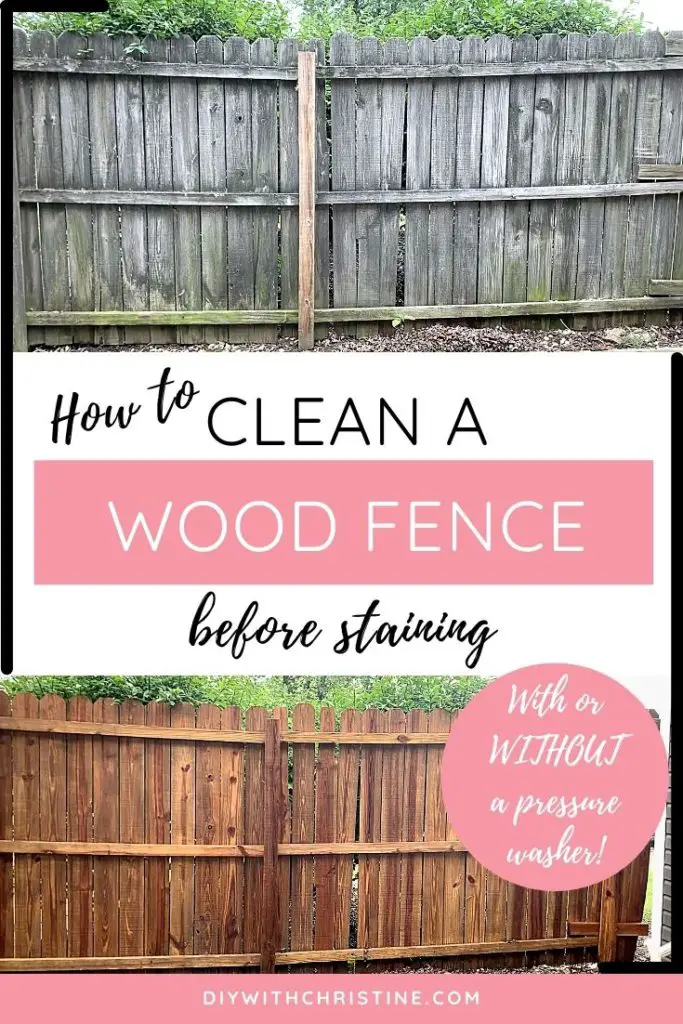

By Christine
Christine is a blogger and DIYer who tackles home renovation and decorating projects alongside her husband, Adam, for their personal residence and rental properties. Although she successfully tackles large renovation projects to avoid expensive contractor fees and bring her vision to life now, her path to success was not easy.
Go here to read her story, “From a Clueless First-Time Homebuyer To A Confident DIYer Creating Her Dream Home One Project At A Time“.
Popular Posts
DIY With Christine is a participant in the Amazon Services LLC Associates Program, an affiliate advertising program designed to provide a means for sites to earn advertising fees by advertising and linking to Amazon.com.

